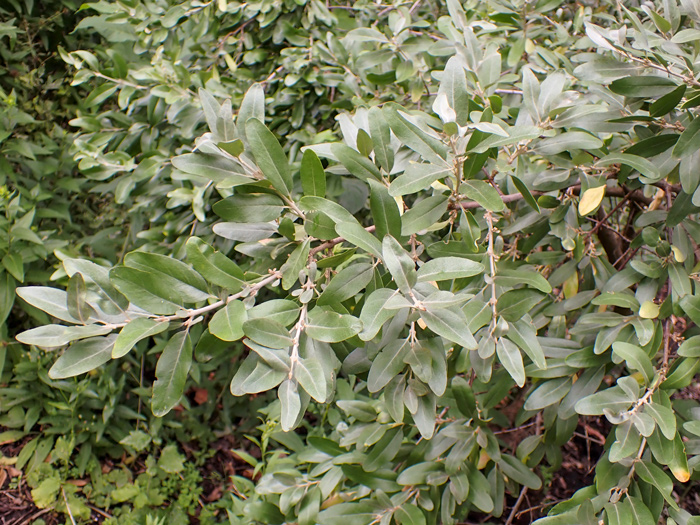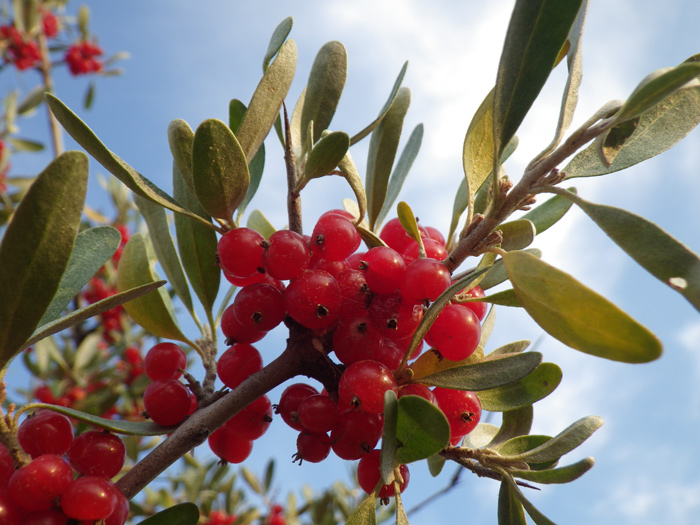Silver Buffaloberry
- Shepherdia argentea (Pursh) Nutt.
- Oleaster family (Elaeagnaceae)
Narration:
General Information
- Plants: Silvery, erect shrubs with stiff branches ending in sharp spines. Leaves have a grayish green color, arranged in pairs opposite each other on the stems. Leaves oblong with rounded ends and entire margins.
- Flowers: Small, yellowish, appearing just as the leaf buds burst.
- Fruits: Reddish orange, tart, juicy berries.
- Flowering Season: April to June.
- Habitat/Range: Ravines and dry hillsides from Minnesota to British Columbia and south to Nebraska, New Mexico, and California.1
Blackfeet Ethnobotany*
by Darnell and Smokey Rides At The Door
The Blackfeet name for silver buffaloberry is Mii K Sinit Tsii Ma. It translates to ‘red bull berry’, which persists as an alternative common name for this plant today. These berries are collected after the first frost, which sweetens the bitter-tasting fruits and enhances the flavor. The traditional method of harvesting these berries is through a process given by Napi, or the Old Man: a hide is placed under the bush, and in order to prevent scratches from the thorn of the plant, the bush is hit repeatedly with a stick. This causes berries to fall into the hide, which are then collected for various uses.
Though, by today’s standards, the berry is bitter, when mashed into a froth it is referred to as 'Indian ice cream,' and children traditionally were given a juice consisting of the juices of many berries, including bull berry. These berries are used in many Blackfeet ceremonies as a component to berry soup. It is also used as a tonic, and is rich in vitamin C and other nutrients.2
From the Journals
by H. Wayne Phillips
There are two specimens of silver buffaloberry that were collected on the Lewis and Clark Expedition and still exist in the Academy of Natural Sciences in Philadelphia.3 They were collected at the mouth of the Niobrara River in present-day Nebraska on September 4, 1804. One specimen has an original label in Lewis's hand. He wrote that specimen number 39 was:
obtained at the mouth of the River Quiccourre [Niobrara] from which place upwards it is abundant in the Missouri bottoms it is a pleasant burry to eat—it has much the flavor of the cranbury, and continues on the brush through the winter—this is an evergreen shrub."
Clark noted this about buffaloberry on October 2, 1804:
The Mandans Call a red berry common to the upper part of the Missouri As-say the engages [French boatmen] call the Same berry grease de Buff—grows in great abundance a makes a Delightfull Tart.
The mouth of the “River Quiccourre” marks the boundary between the Tallgrass Prairie and the drier High Plains. As they entered the High Plains the explorers recorded their first sighting of a mule deer on September 5, 1804. They anticipated many new plant and animal discoveries ahead.4
Additional Information: While the berry from the silver buffaloberry is not an excellent source of energy or protein for grazing, larger animals, the fruits are sufficient for smaller mammals and birds. The tree provides shelter for small mammals and birds on the plains, and the silver buffalo berry has been used extensively to restore prairie habitats and curb erosion.5
*While traditional medicine is still practiced in many cultures including the Blackfeet culture and has many uses, please do not consume any plant material without consultation of a health professional.

© 2006 by Matt Lavin. Permission to use granted under the Creative Commons Attribution-ShareAlike 2.0 Generic (CC-BY-SA 2.0) license.

Botanischer Garten Halle. © 2022 by Krzysztof Ziarnek. Permission to use granted under the Creative Commons Attribution-Share Alike 4.0 International license.

Missouri Headwaters State Park. © 2012 by Matt Lavin. Permission to use granted under the Creative Commons Attribution-ShareAlike 2.0 Generic (CC-BY-SA 2.0) license.
Notes
- "Shepherdia argentea (Pursh) Nutt," United States Department of Agriculture Natural Resources Conservation Service Plant Database, plants.usda.gov/home/plantProfile?symbol=SHAR.
- All ethnobotanical information was given or verified by Smokey Rides At The Door and Darnell Rides At The Door. Initial research came from Native American Ethnobotany Database. Please be advised that not all studies included are correct and to consult with Native community members to verify information.
- H. Wayne Phillips, Plants of the Lewis and Clark Expedition (Missoula, Montana: Mountain Press Publishing Company, 2003). H. Wayne Phillips graciously donated his expertise on this subject by writing this narrative.
- The Definitive Journals of Lewis & Clark, Gary Moulton, ed.
- Lora L. Esser, "Shepherdia argentea: Fire Effects Information System," (1995) www.fs.usda.gov/database/feis/plants/shrub/shearg/all.html.


